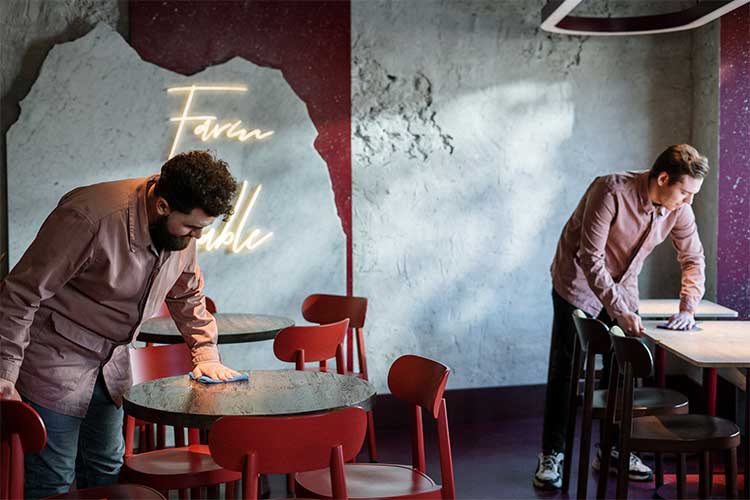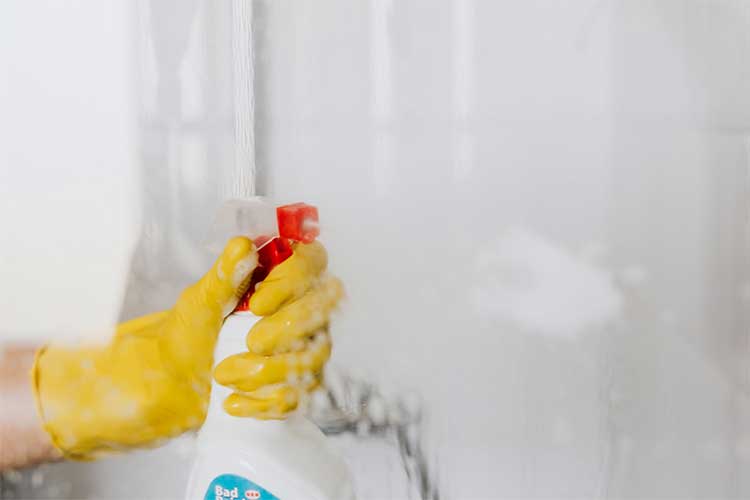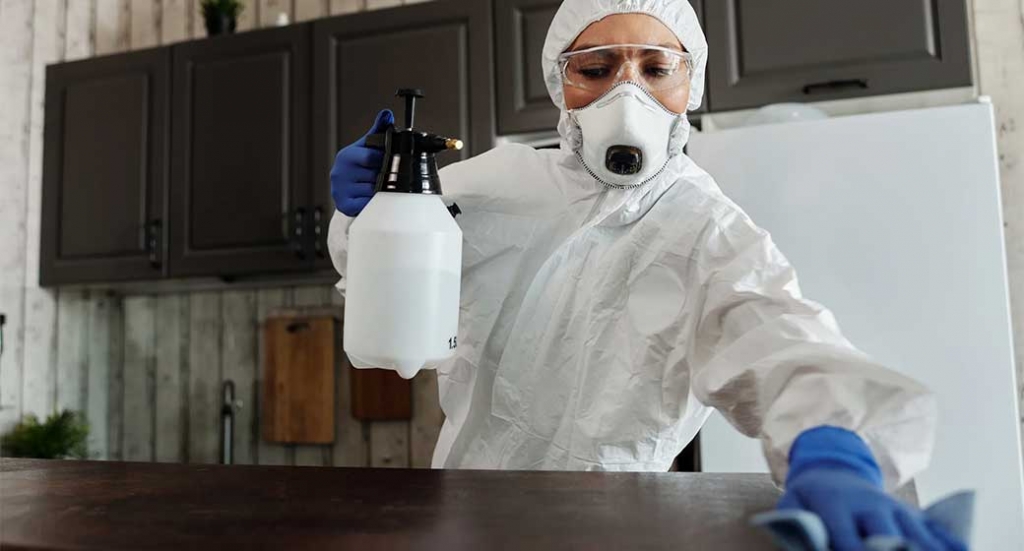The New Normal: Part of a new series of articles focused on restaurant recovery; issues, best practices, and process changes that will become part of everyday business going forward.
You may have heard about restaurants that are deep cleaning for COVID-19. But what does that actually mean? Does it mean you are disinfecting things? Sanitizing? What products or chemicals are used to achieve a deep cleaning? When is a deep cleaning for COVID-19 needed? Let’s dig in.
What does it “Deep Cleaning for COVID-19” Really Mean?
We assume that every restaurant has a set of cleaning standards that it tries to uphold every day. You clean the bathrooms. You sweep the floors. Trash is taken out. But wiping down the tables with a damp dishrag is NOT a deep cleaning.
When people talk about “deep cleaning” they are referring to cleaning and disinfecting on a whole new level. This could include cleaning things that were not typically cleaned regularly in the pre-coronavirus era. For example, most restaurants didn’t think about cleaning and disinfecting their plastic-covered menus (unless they were visibly dirty). The same thing might be said for the cash register, point-of-sale, or touchscreen order entry system. But these high-touch items are now main targets for deep cleaning.
Cleaning vs. Sanitizing vs. Disinfecting
Cleaning refers to removing dust, dirt, and debris from a surface or material, often using soap and water or a mild commercial cleanser. Sanitizing reduces bacteria on a surface or material. The type(s) of bacteria should be specified on the cleaning agent’s label. And this is the key. You see, EPA-approved sanitizers are only rated against bacteria, not viruses. So, for COVID-19, sanitizers are ineffective.
On the other hand, disinfectants are rated for both bacteria and viruses. An EPA-approved disinfectant should be able to kill or inactivate viruses on hard surfaces. And this is what you really want to achieve to battle COVID-19.

When is a Deep Cleaning for COVID-19 Really Needed?
There are no structured guidelines for deep cleaning. In fact, the term “deep cleaning” itself isn’t officially recognized by the Centers for Disease Control (CDC), the Environmental Protection Agency (EPA), or the World Health Organization (WHO).
“Deep cleaning” is a term that has gained popularity and traction in the industry to describe cleaning processes and procedures that are over and above ordinary janitorial processes.
That being said, undertaking a deep cleaning initiative can be time-consuming and have expenses beyond those normally incurred by the business. So, planning and timing become critical for business planning.
Much like it is difficult to clean your house while your kids are inside making messes as quickly as you can clean them up, you can’t really do an effective deep cleaning while your restaurant is open and operating. That means you will either have to close your business or complete the deep cleaning after business hours.
Start from a Good Baseline
There is no right answer as to when you should do a deep cleaning. But as you attempt to reassure nervous customers, you should try to start from the best position possible. So, before there are any precipitating incidents, you should undertake a deep cleaning to set your baseline.
Daily, Weekly, and Monthly Plans
Not everything needs to be deep cleaned every day. It’s simply not practical for some things. But you should create a real plan for your cleaning procedures. Documentation will be critically important in the event of any kind of infection incident.

What Needs to Be Deep Cleaned?
The short answer: Everything.
First, some facts and science. In March, a study on COVID-19 found that the virus hung around on different surfaces for differing lengths of time. Copper surfaces were best. The virus was undetectable on copper surfaces after just 4 hours.
But copper surfaces are not often found in restaurants, so that’s not very helpful. The bad news is that some of the most common surfaces found in restaurants were also the ones that showed traces of the virus up to several days after initial exposure.
Cardboard surfaces remained infectious for 24 hours after initial exposure. Many restaurant supplies and deliveries come in cardboard boxes. Therefore, you can’t simply ignore your stock room when deep cleaning for COVID-19.
The worst offenders are also the most common materials found in restaurants: Stainless steel and plastic. These surfaces remained infectious for up to 3 days or more. Most commercial restaurant equipment is made from stainless steel. And plastic is ubiquitous in modern life so it is virtually everywhere.
Where to Begin
To truly deep clean for COVID-19, start with all surfaces. And we really mean ALL surfaces. There are the obvious ones: Tabletops, counters, prep surfaces, etc. But if you want to do it correctly, you need to go well beyond the obvious.
Start with the walls. Floor to ceiling if you can manage it. Do the walls in the front of the house and the back of the house.
Next, focus on high-touch areas. These are your obvious areas. Pay special attention to surfaces that customers come into contact with routinely. Now think about the “hidden” surfaces attached to those obvious surfaces. When was the last time you cleaned or disinfected the underside of your tabletops? We would bet never.
The same goes for the back of the house areas. Sure, you clean the inside of the sinks. But what about the outside and underside of the bowls? What about the tops of your refrigerators? Are you getting the idea? You have to get a little obsessive.
Of course, many of these areas are not things you will need to clean and disinfect daily. But starting from a good deep cleaning point will help you look for trouble spots that you will need to remember and document later on.

Tools & Products For Deep Cleaning for COVID-19
As we mentioned before, you probably already have a set of cleaning guidelines that you expect your employees to follow. We are not suggesting that you throw this plan away. In fact, it’s a great place to start. Most cleaning plans address removing visible dirt and debris from surfaces. You should definitely do that. And you probably have all the tools and chemicals needed already.
Wipe down surfaces using soap and water or a mild commercial cleanser. Be sure to rinse and wipe clean where applicable. But this is just step one.
After you have done your normal cleaning, it’s time to disinfect. Disinfecting begins by using an EPA-approved cleaning product or solution. Use as directed on the appropriate surfaces. Check to be sure that the disinfectant you are using is safe for the surfaces you need to disinfect.
Shop All Cleaning, Disinfecting, & Sanitizing Supplies
You also probably already have another piece of equipment that can be useful in fighting coronavirus: A commercial dishwasher. Wash what you can in your commercial dishwasher with the appropriate, manufacturer-approved chemicals and soap. Think outside the box here. You might have items besides flatware, dishes, and cookware that can be cleaned in a dishwasher.
Paper Towels or Rags/Cloths
You will find some debate on this topic. There are benefits to each. Paper towels are disposable and thus, are less likely to cross-contaminate surfaces. Rags or cloths are reusable and thus, less expensive in the long run.
However, cloth cleaners should not be used for multiple jobs. They should be treated as single-use items. If you wipe a counter using a disinfectant and a cloth, you should not use that cloth again until it has been properly laundered. This is to avoid any chance of cross-contamination.
A combination approach can definitely work. For example, you can use a cloth with warm, soapy water to do the initial cleaning of a surface to remove dirt and debris. But then follow it up with an EPA-approved disinfectant applied and wiped down with a paper towel. Then dispose of the paper towel after each initial use to avoid cross-contamination.
Linens, Rugs, Drapes and Other Soft, Porous Surfaces
If you are still using cloth table cloths or linen napkins, we would suggest you suspend those practices for now. There isn’t enough research on how the virus operates on those surfaces to feel safe. And there isn’t a good way to clean and disinfect these surfaces between uses. So if you are completely changing the table cloths between customers, you might be ok. But better to keep them out of the equation altogether.
You can launder some fabrics and other materials in a washing machine. Make sure you check the care instructions for the item and follow the washing machine manufacturer’s guidelines for use. These materials can be some of the trickiest to clean and disinfect. So, in the interest of safety and ease, you might want to consider removing these items for the time being.

Foggers, Cold Steamers, & Disinfecting Misters
This is another topic that stirs some debate. We have seen the use of these fogging systems skyrocket since the onset of the global pandemic. And in many instances, they can be a helpful adjunct to your deep cleaning routine.
However, they should never be the ONLY method used for disinfection. Foggers use a disinfecting solution and a sprayer to create positively charged particles that can adhere to surfaces. Surfaces are most often negatively or neutrally charged and opposite charges attract. It is believed that by having the disinfectant spray cling to surfaces that you can achieve better disinfection, especially across larger areas or hard to reach spaces.
It should be noted that the CDC does not have any guidelines for the use of these foggers currently. Some believe that simply fogging an area can lead to a false sense of security at best and, at worst, might be a violation of federal law (because it goes against the labeling requirements for the disinfectant that include pre-cleaning as part of the process).
Fogging in Restaurants
So, foggers can be a helpful adjunct to your deep cleaning process. But experts believe that wiping surfaces down with a paper towel and an EPA-approved disinfectant is still the best way to disinfect a surface. Much of this comes from the friction applied from the wiping which you do not get from simply fogging a surface.
The last issue with fogging in a restaurant setting is that you need to be sure that the disinfectant used is food-safe. You will also want to either remove any glassware, flatware, and china before fogging. Otherwise, you will probably need to rewash all those items before using them with customers. And even if you do fog with a food-safe, EPA-approved disinfectant, you will probably want to wipe down food prep or cooking surfaces before using them again.
Quick Tips for Deep Cleaning for COVID-19
- Wash your hands thoroughly before you begin, when you end, and every time you switch tasks.
- Wear gloves that are appropriate for the cleaning materials you will be using. Using gloves does not eliminate the need for proper handwashing.
- Do not mix cleaning chemicals without guidance from the manufacturers of all the substances involved. Improper mixing can cause harmful and potentially toxic fumes.
- If you dilute cleaning chemicals to put in your own reusable spray bottles or other applicators, label them thoroughly.
- Wear proper skin protection and consider using protective eyewear when using cleaning chemicals.
- Make sure you have proper ventilation when using cleaning chemicals.
- Follow manufacturers guidelines on all products. Do not use more than recommended.
- Use EPA-approved disinfectants only.
- Dispose of and remove paper towels used in cleaning and disinfecting immediately. If using cloths instead, be sure to wear gloves when handling the dirty cloth rags and wash them appropriately in a washing machine before reuse.
You Are Ready to Deep Clean!
As we noted earlier, you should definitely document your plans, processes, and any steps that you have already taken to enhance the cleaning procedures for your establishment. Doing so could become crucial if a worker tests positive for COVID-19 at some point in the future.
By investing some extra time and effort into your cleaning procedures, you are concretely demonstrating your commitment to the safety and well-being of both your customers and your employees. And at the end of it all, that’s what truly matters.
So get cleaning!





Deep cleaning is cleaning the surface and making sure that viruses that cannot be seen by naked eyes were kill by using a disinfectant.